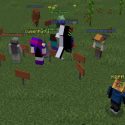This is a Theological Reflection using the Whitehead and Whitehead, Correlation Method. I will proceed through Attending, to particular pastoral concern. Secondly, Assertion to expand and deepen religious insight. Thirdly, Decisions moves decision making for action based on the insight gained.
Attending
I had been noticing several aspects of the way collaboration and interaction happens in church times together and also at other times during the week. For many players coming to the server meant movement from individualist building to co-creating and collaborative building with others. This required a degree of negotiation (who can build where and what) and reconciliation (because of unintentional and intentional ‘griefing’) Practising this form of collaboration is not natural for all at first. Teenagers can forget how to do this but I noticed the younger players (7-8 year-olds) were much better. They would give strong suggestions on what to build but not how to do it.
When canvassing players’ desires for the server community, teaching each other how to build was noted as important. I often see that requested or remarked upon. Players are good at helping players. They ask for help too.
For adults, being a non-gamer or ‘newbie’ to Minecraft actually seems to be an advantage. It is a great leveller. Adults need to rely on younger players to tell us how the world works and to do better building than we can do. Our job is to facilitate flourishing and provide some essential boundaries (safety, server functions, payments!) and structure to the sessions.
People hugely value praise and appreciation for their builds. I saw that particularly when running a sculpture competition. The positive criticism of their creations by an external artist was deeply encouraging for them.
The players value their collaborative builds highly. When I asked about favourite builds, a banqueting hall and skyscraper were quickly noted which had been created by six or more of us. The collaborative builds seem to get less griefing too than individual builds.
Assertion
What sort of culture is there in the server? The wonderful thing about the Christian message is that it is not tied to any culture but has gone into all the world and is adapted, translated and enriched by all the cultures it is accepted in.
I would like to suggest that there is a different cultural space in Minecraft Church. This is a form of game space or an affinity space around Minecraft. I will touch on this more in Gamespace as Noosphere.
In my search to understand the culture, I came across a number of studies that have looked at Minecraft and other forms of social media or computer games. I was impressed with the idea of Participatory Culture as outlined by Jenkins et al. They wanted to know why within informal learning cultures such as affinity spaces, “people learn more, participate more actively, engage more deeply with popular culture than they do with the contents of their textbooks.” The key idea they have is that a different form of culture is created by new forms of media that have grown out of the literate print-based culture of the 20th Century. Technology has enabled new ways of being. This has formed new types of culture. They call this Participatory Culture and describe five keys aspects:
- With relatively low barriers to artistic expression and civic engagement
- With strong support for creating and sharing one’s creations with others
- With some type of informal mentorship whereby what is known by the most experienced is passed along to novices
- Where members believe that their contributions matter
- Where members feel some degree of social connection with one another (at the least they care what other people think about what they have created).
These five simple points bear striking relation to what I had been attending to: anyone can make something in Minecraft. A box becomes a house when a door is added. Just as in Lego, constructions created from a limited number of ‘bricks’ can take elaborate and sophisticated forms given the skills of the creator. There is a low barrier to entry here.
The sharing takes place in the server space. In our case over several interconnected worlds. Everyone can explore others’ creations (if they can find them!) Mentorship takes place all the time as I noted regarding new skills and crafting abilities. For example, there is currently a firework display in construction. It gets more elaborate as more people work together learning from each other in turn.
Making contributions matter is evident in our mutual building during Minecraft Church time in particular; we all explore by building together. This blends into the fifth point of social connection. I have deliberately enhanced this by using Zoom, adding voice and visual facilities for interaction. This builds upon the simple but richly used physical movements of the player characters and text-based chat.
As Jenkins and other commentators look at Participatory culture a number of other points struck me. Ellison noted how vital the need was to foster mutual respect. There is a strong need to “create spaces that foster mutual respect, active participation and the negotiation and co-construction of meaning.” While it does not happen much I have spent time working to bring reconciliation between players who fall out. This is mostly due to ‘griefing’ (the destruction of something important built.) Griefing is well named and I have observed these powerful emotions at work. While our server is considered a “peaceful place” by many players there still is a need for reconciliation. This is a wonderful opportunity to practice the commands of Christ to forgive and grow in such skills. A skill I hope will flow into the physical world too. Jenkins notes that “Today’s children learn through play the skills they will apply to more serious tasks later.”
Boom et al in their report discuss how they used Minecraft in a museum context to explore Roman architecture. They drew on theories of Kolb noting “In essence, video games are playful manifestations of experiential learning theory”
They noted many of the collaborative points commented above. Families would explore the Minecraft experience together. They noted that different members took different roles: “(grand)parents were often best placed to ‘translate’ the provided archaeological knowledge;” This helpful insight gives me new ideas of how to draw adults more deeply into what we are doing. I would very much like to have an all-age experience, but recognise that at the moment we are primarily working with children. However, one close friend of mine, Rodney, joins with his adult daughter and sometimes without her. He does not play Minecraft but is an avid gamer. His comments, jokes and Christian insight have been reported again and again as beneficial. I liken his influence to that noted by Boom et al.
They also noted that some players engaged in ‘counterplay’. Counterplay looks like disruption but they spotted within it that learning was happening through deliberately playing with the opposite. This very much changed my mind about the value of such behaviour that I have encountered. Going in opposite directions has enabled a really interesting development of ideas. Particularly when balanced with the ‘translating’ role noted above or taking the conversation in a ‘wondering’ direction.
There are some important critical points that I noted. Boom is concerned that their report is mostly anecdotal and informal, they are not yet confident about how effective their impact really is. As gaming space is becoming more utilised (Minecraft has a special education edition for example) it is important to recognise that their “raison d’être is the generation of economic revenue. As such, they often provide a relatively narrow and shallow experience of the past.” They especially warn Computer Games can provide “shallow experiences of the past [that] are driven by violence.”
Participation and collaboration are strong themes in Christian theology with particular application to a theology of the Trinity. The relationship in the Godhead is one of mutuality and also difference. Distinct functions yet mutual reliance and submission.
In the forms of church in the book of Acts that spring up, we can see how teams of elders were appointed, placing collaborative leadership above individual leadership. As the apostles wrote: “It seemed good to the Holy Spirit and to us…”(Acts 15:28)
Decisions
The clear pastoral decision here is to embrace Participatory Culture deeply in our inculturation of the Christian faith. Can we disciple one another in a participatory-cultural way? Can I foster the environment to provide that?
Taking ideas of the church from one culture into a new culture is a form of ethnocentrism or colonialism. I need to be committed to patiently discover what this culture can produce through participation and collaboration. It is clear that already there is an insight into sin through ‘griefing’. There is a strong pull toward Creation as we constantly are in a process of co-genesis. I had a strong feeling that we will discover an important aspect of soteriology as we ponder creation, grief and what redemption is. This will also require assistance from the adults who join us to help with the ‘translation’ process.
I have started a fortnightly planning meeting open to all (any age) to come and consider together how to progress. As lockdown is lifting we also have the possibility of physically meeting together. We need to consider how the participatory culture can continue when face to face too.
I feel I have struck a vein of rich ore here and one I want to continue to mine. Rather an apt metaphor for Minecraft!
Bibliography
(For full bibliography see Bibliography)




Leave a Reply